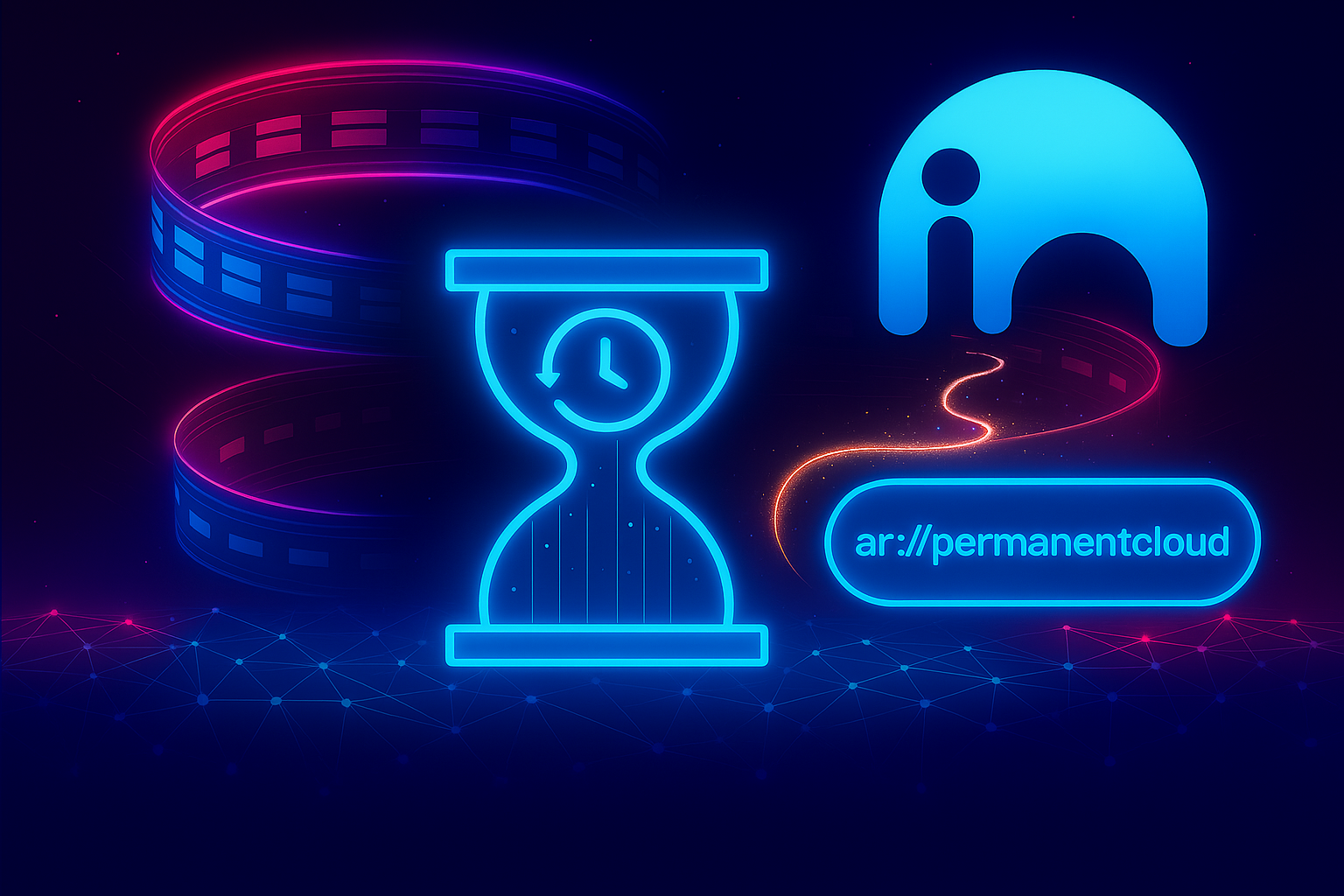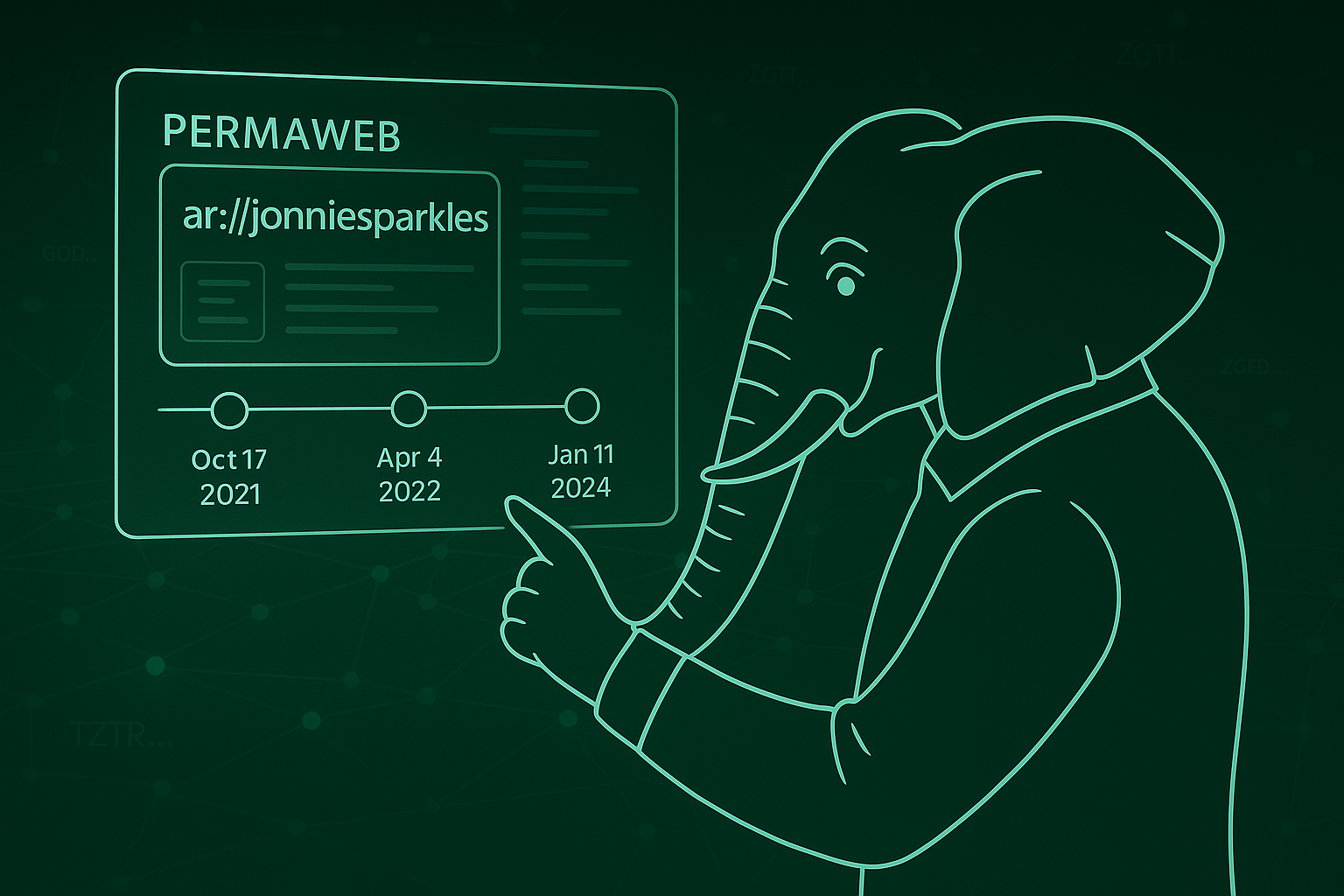Building a Rewindable Internet with ArNS
by @JonnieSparkles
2025-03-26
Introduction
In the Many Layers of Permanence series, we explore how Arweave and its ecosystem ensure digital data outlasts those that created it. Earlier articles covered layers such as censorship resistance and open-source principles. Here, we examine a new layer - historical transparency - enabled by the Arweave Name System (ArNS) and the "time machine" capability of the AR.IO permanent cloud network. Unlike traditional archival methods, AR.IO allows users to not only access permanent data but also rewind and explore the permaweb's past states, preserving the historical context behind data changes. This capability introduces accountability, richer historical insight, and a uniquely transparent view into the evolving landscape of digital content, distinguishing the permaweb significantly from other web technologies. Historical transparency, as a layer of permanence, makes the rewindable internet possible by ensuring that past states are preserved and accessible for exploration.

Arweave, the Permaweb, and ArNS: A Foundation for Permanence
Arweave is a blockchain protocol designed for permanent data storage. Once data - a webpage, app, or file - is uploaded, it remains accessible indefinitely, forming the permaweb: a decentralized web where content cannot be modified or removed, whether unintentionally or maliciously. This immutability is a core feature, supported by Arweave's endowment model, in which upload fees sustain storage costs over centuries.
Navigating the permaweb initially relied on transaction IDs - long, complex character strings - to identify stored data, which can make navigation difficult. The Arweave Name System (ArNS), developed by the AR.IO Network, solves this by associating human-readable names, such as ar://permanentcloud, with these transaction IDs. Using the Wayfinder protocol (ar://), names route through AR.IO gateways like arweave.net, resolving them to their corresponding transaction IDs. Acting as a decentralized DNS, ArNS utilizes Arweave Name Tokens (ANTs) and maintains its registry directly on Arweave. ArNS provide static domains for dynamic content while gateways enable seamless and user-friendly access to permaweb content.
The Time Machine
AR.IO's "time machine" introduces critical functionality of permanence through historical transparency. Every ArNS name, including its ownership and the data it points to, is recorded permanently as a transaction on Arweave. Because Arweave data cannot be modified or deleted, these transactions form an immutable record of a name's history. Users can query this record to see the state of a name at any specific moment - for example, what ar://jonniesparkles pointed to before this article was published, or who owned it at that time (spoiler, it was me).

This capability extends to the entire permaweb namespace. The ArNS Registry, which tracks all registered names, is stored directly on Arweave, enabling reconstruction of the entire namespace at any historical moment. This provides complete snapshots of past permaweb states, including every name, its owner, associated data, and the publisher (when known). AR.IO's gateways make this possible by accessing both current and historical transactions, effectively letting users view the permaweb as it existed at any point.
The mechanics behind this rely on AR.IO's design. Data exists as timestamped transactions on Arweave, and ArNS uses Arweave's AO compute layer to manage its registry and name tokens (ANTs). By storing every transaction permanently, Arweave (via AO) ensures that historical context remains as permanent as the data itself - including ownership transfers, linked content updates, and namespace evolution. Archiving these interactions is just as important as the data itself for historical context, as they reveal the dynamic story of how the permaweb has been used and shaped over time, offering a richer understanding of its history.
What Makes This Different
What makes this time machine particularly noteworthy is its novelty. While tools like the Internet Archive's Wayback Machine archive the traditional web, they operate on a centralized model, relying on a single organization to crawl and store data, deciding what gets preserved. The permaweb's time machine, by contrast, is fully decentralized and baked into the protocol. Every change to an ArNS name or the broader namespace is automatically recorded on Arweave, eliminating third-party control over data preservation. This guarantees completeness and immutability that centralized systems cannot achieve - there's no risk of data being missed, altered, or lost due to server failures, cut budgets, or policy changes.
No other decentralized technology offers built-in historical transparency in this way. Blockchains like Ethereum and protocols like IPFS can store data, but they lack a native mechanism to preserve and query the historical state of a decentralized namespace. Ethereum emphasizes smart contracts and state changes but doesn't prioritize permanent storage of web content history. The Ethereum Name Service (ENS) maps names to addresses but doesn't provide a protocol-level mechanism to archive the historical state of the namespace like ArNS does. IPFS allows decentralized storage, but data permanence depends on continuous pinning, and it has no native naming system that tracks history. AR.IO's time machine, integrated directly into its protocol, represents an entirely unique solution, making the permaweb a uniquely transparent, historically rich, and unified ecosystem.
Historical Transparency in Action
Historical transparency has practical applications - particularly in politically sensitive contexts. Governments frequently face criticism for revising or deleting statements and policies, obscuring past positions. Imagine government websites permanently archived on the permaweb using ArNS. For instance, if a government publishes a climate policy and later modifies it due to public or political pressures, a permaweb archive under an ArNS name like ar://govclimate preserves every version. Using the time machine, anyone can revisit the original policy, compare revisions, and hold officials accountable. Amid heightened tensions over issues like election integrity, climate change, or {insert topic du jour}, such transparency becomes critical. Journalists, researchers, and citizens could leverage the permaweb's immutable records to verify facts and counter historical revisionism.

The time machine also exposes broader digital trends. Imagine a permaweb search engine letting users compare snapshots before and after AI became prevalent - for instance, contrasting January 1, 2023, with January 1, 2025, capturing the period when AI tools reshaped online interactions. Such comparisons could reveal how communities adapted, illustrating the emergence of AI-driven apps, shifts in user-generated content, or evolutions of the digital hive mind. These insights offer clarity about transformative eras otherwise lost to time.
Beyond accountability and research, the time machine provides protective benefits. Users can access versions of apps or sites before harmful updates or security breaches. For example, if an application named ar://totallysafe (an ironic nod to incidents like the January 2025 Safe multisig hack, where malicious modules compromised user wallets) introduces invasive privacy changes or becomes infected with malware, the time machine allows users to rewind back to an earlier, trusted version. This strengthens user control, security, and trust, further positioning the permaweb as a secure environment for digital self-sovereignty.
A Vital Layer of Permanence
AR.IO's time machine, powered by ArNS, enables a vital layer of permanence: the preservation of historical context. By maintaining an unalterable record of the permaweb's evolution - both its data and the interactions that shape it - it ensures that the history of decentralized content is always accessible, whether for accountability, research, or protection. Its novelty lies in its decentralized, protocol-level approach - no other technology provides this level of historical transparency.

Historical transparency offers a counterbalance in a world where rights are temporary and data is easily rewritten, reinforcing the permaweb’s role as a rights-preserving, permanent archive. While there’s more to build, the AR.IO Network continues to make the permaweb more accessible and functional, moving us closer to the full realization of the time machine. As part of the Many Layers of Permanence series, this look at historical transparency shows how Arweave and its ecosystem are redefining what it means to preserve data - not just the content itself, but the context and story behind it.